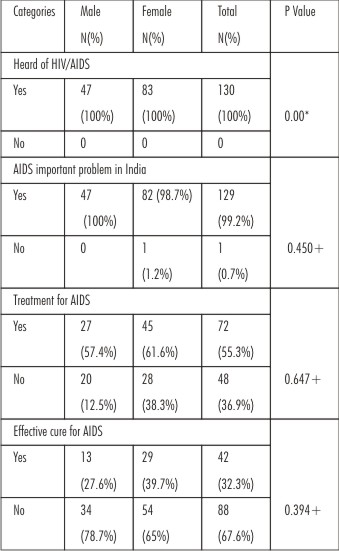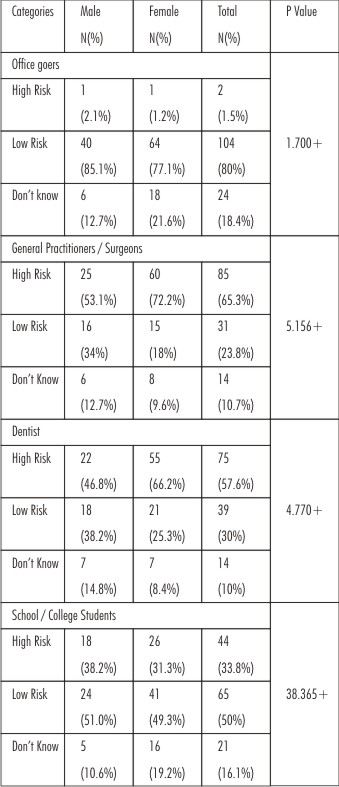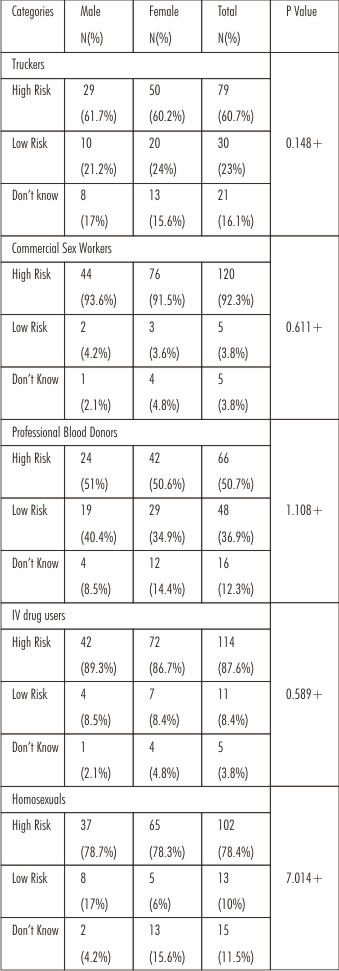Introduction:
The AIDS epidemic is continuing to grow [1]; global estimates indicated that over 40 million people are infected by the disease [2].The fact that the number of HIV-infected patients under dental care is expected to increase[3] ,highlights the importance of providing dental treatment to all individuals indiscriminately[4].The reports indicated that about 90% of the HIV infections among healthcare workers occur in developing countries where occupational safety is a neglected issue [5],[6],[7].
Chennai has low HIV/AIDS prevalence. Although figures are low compared to southern Africa or Asia, they are still a cause for alarm, particularly since they are rising rapidly, especially among high-risk groups [8].
The human immunodeficiency virus (HIV) is the virus that causes AIDS. HIV attacks the immune system by destroying CD4 positive (Cd4+) T cells. The acquired immunodeficiency syndrome (AIDS) is the end stage of HIV infection. A person infected with HIV is diagnosed with AIDS when he or she has one or more opportunistic infections, such as pneumonia or tuberculosis, and has a dangerously low number of CD4+ T cells less than 200 cells per cubic millimeter of blood [9]. All dental students should have complete knowledge about the universal precautions which is an administrative control measure that calls for the implementation of practices and equipment to protect the health care workers whenever the potential exists for exposure to blood. Every patient is considered to be infected with a blood-borne pathogen regardless of the known sero-status [10].
Dentists have a responsibility to provide treatment for HIV infected patients, particularly because oral lesions are common among these patients. It is obvious that having adequate knowledge about HIV / AIDS enhances confidence in student’s ability to manage infected patients. Hence this study aims to know the current status of knowledge regarding HIV/AIDS among dental students.
Materials and Method:
Study Area: The study area comprised of dental students from Chennai. The number of dental colleges in Chennai is 11. From the list one college was chosen at random and all the subjects from across various grades were included in the study.
Study Population: A total of 130 clinical students of age group 22-25years of a randomly selected university participated in the survey during April 2011.The subjects included were the undergraduates and post graduates. The subjects present on the day of examination were only included.
Methods: Ethical clearance was obtained from Ethical Committee of Department of Public Health Dentistry. A pre tested questionnaire, comprising of 31 questions was issued to each participant. The questions fell in six main categories. First the respondents were asked about their general awareness about HIV / AIDS. Second they were questioned on the knowledge of subjects regarding the modes of transmission. The third group of questions was about the belief in communicability. The fourth group of questions was regarding the knowledge about safe sex. The fifth group of questions pertained to the office goers’ relationships, general practitioners, dentists and school/ college students and last they were asked about the knowledge of high risk groups. The respondents took approximately 10-15 minutes to complete the questionnaire. The questionnaire was distributed in person and collected on the same day.
Calibration:-The questionnaire was pretested before starting the study on a group of ten students. Based on the difficulties faced by the students the questionnaire was modified subsequently.
Statistical Analysis: The statistical analysis was done using SPSS version 10 software Chi square tests was used to check for statistical significance.
Results:
 | Table 1: General awareness about HIV / AIDS
 |
Table I shows General awareness about HIV / AIDS. The survey has revealed that 100% of the subjects have heard about HIV / AIDS. Similarly 99% of the subjects reported AIDS being an important problem in India only 58% of the male subjects and 62% of the female subjects reported that there is treatment available for AIDS. Likewise only 28% of male subjects and 35% of female subjects believed that there is an effective cure for AIDS.
 | Table 2: Knowledge of subjects regarding the modes of transmission
 |
Table 2 shows knowledge of subjects regarding the modes of transmission. This table contains questions regarding the mode of transmission of HIV/AIDS. After the survey it was observed that majority of the dental students had knowledge about mode of transmission of HIV like sexual inter course 100%.Likewise 95.7% male and 98.7% female,97.8% male and 100% female,82.9% male and 59% female reported needle /syringes, transfusion of blood, mother to child transmission were different modes of transmission of HIV/AIDS.
 | Table 3: Beliefs about communicability
 |
Table 3 shows beliefs about communicability. This table revealed the knowledge of dental students on beliefs about communicability. Here 68% of the subjects have correct knowledge regarding modes of transmission by mosquito, sharing clothes, utensils or shaking hands with HIV infected persons. 87% of the study subjects have correct knowledge about body contact in public places or sharing a pool not being modes of transmission.
 | Table 4 : Knowledge about Safe Sex
 |
Table 4 shows knowledge about safe sex. After the survey was done, it was observed that majority of the study participants (90%) of both genders consider sex without condom to be of high risk. The level of knowledge was lower regarding faithful couples(79.2%) and sex with condom being at the lowest risk.
 | Table 5: Knowledge about risk Perception
 |
Table 5 shows knowledge about risk perception. The survey has revealed that 80% of the dental students are aware that office goers were not a high risk group. 29%, 30%, 50% were perceived by general practitioners / surgeons, dentists, school / college going students respectively to be low risk group.
 | Table 6 : Knowledge about high risk group
 |
Table 6 shows knowledge about risk group. We observed that 80% of the subjects have correct knowledge that truck drivers, commercial sex workers and intravenous drug users are at high risk. Whereas level of knowledge was lower in correctly identifying professional blood donors (51%) and homosexual (79%) to be at high risk.
Discussion:
A significant number of students did not know when it is possible to confirm the HIV infection. The inadequate knowledge of HIV virology was also reported by Nigerian and Sudanese dental students.
Since oral lesions are common in HIV / AIDS patients, oral health care is an important component of their treatment plan. Although many dentists used to reject providing dental treatment to AIDS patients, dentists attitude toward the treatment of these patients have improved in recent years.
A study conducted in Jordan few years ago to investigate willingness of working dentists to treat HIV infected patients has show that, when a fake AIDS patient contacted dental practices by phone for treatment of pain of dental origin, there was fear of the HIV illness and only15% of dentists accepted to provide such treatment.
The fear of treating HIV infected patients was further revealed by the inadequate knowledge of HIV transmission reported by the students participated in this study. Evidence indicated a low occupational risk for HIV infection among health care professionals. The highest risk was following a needle prick injury and has been estimated as less than 0.5% per accident. Using IV drugs is a possible transmission route and has been considered by the vast majority of students.
Clinical dental students in particular may encounter a number of incidents where infections, including AIDS, from patient's body fluids may occur. In comparison to other infectious diseases, dental students were found to be more willing to treat HBV- and HCV-infected patients than those with HIV infection [11]. Male students were reported to have significantly stronger negative attitudes towards patients at risk for or with HIV infections/AIDS than female students [12]. Dental students were reported to favour the inclusion in their tutored programs a more comprehensive material about patients with HIV infections/AIDS, such materials as case studies, discussion groups and closely supervised clinical experiences[12].
In this study, survey was made between under graduate and post graduate dental students regarding their knowledge and attitude about HIV. The sample was homogenous. There were no ethnic or religious variations, future studies are encouraged to study the influence of other factors, which were not studied here such as the social class, the income, education of parents and the area of residency on the student’s attitude towards HIV patients, as this is a limitation of this study. Also future studies are encouraged to hold this study among dental students of the other dental faculty in Chennai and among other health care workers.
Conclusion:
Although a large number of these students claim to be knowledgeable about HIV/AIDS, it is obvious that a true understanding of the disease is lacking. A concerted effort should be made to change the uninformed perception amongst dental students by implementing curriculums that will enhance their knowledge of HIV/AIDS starting from preclinical stage which will be sustained in the clinical level.
References:
1. Cohen LA, Romberg E, Grace EG, Barnes DM: Attitudes of advanced dental education students toward individuals with AIDS. J Dent Educ 2005, 69:896-900.
2. Ogunbodede EO, Rudolf MJ: Policies and protocol for preventing transmission of HIV infection in oral health care in South Africa.S Afr Dent J 2002, 57:469-474.
3. Patton LL: HIV disease. Dent Clin North Am 2003, 47:467-492.
4. Lohrmann C, Valimaki M, Suominen T, Muinonen U, Dassen T, Peate I: German nursing students' knowledge of and attitudes to HIV and AIDS: two decades after the first AIDS cases. J Adv Nurs 2000, 31:696-703.
5. Kermode M, Holmes W, Langkham B, Thomas MS, Gifford S: Occupational exposure to blood and risk of bloodborne infection among health care workers in rural north Indian healthy care settings. Am J Infect Control 2005, 33:34-41.
6. Ansa VO, UdAnsa VO, Udoma EJ, Umoh MS, Anah MU: Occupational risk of infection by human immunodeficiency and hepatitis B viruses among health workers in south-eastern Nigeria. East AfrMed J 2002, 79:254-6.
7. Gumodoka B, Favot I, Berege ZA, Dolmans WM: Occupational exposure to the risk of HIV infection among health care workers in Mwanza Region, United Republic of Tanzania. Bull World Health Organ 1997, 75:133-40.
8. Epidemiological fact sheet on HIV and AIDS. Geneva: WHO/ UNAIDS / UNICEF [http://apps.who.int/globalatlas/predefined Reports / EFS2008/full/EFS2008_JO.pdf]
9. HIV Infection and AIDS, An Overview, NIAID Fact Sheet: NIAID [http://www.wrongdiagnosis.com/artic/hiv_infection_and_aids_an_overview_niaid_fact_sheet_niaid.htm]
10. Centers for Disease Control, Prevention: Guidelines for infection control in health care personnel. Infect Control Hosp. Epidemiol 1998, 19:445.
11. Hu SW, Lai HR, Liao PH: Comparing dental students' knowledge of and attitudes toward hepatitis B virus-, hepatitis C virus-, and HIV-infected patients in Taiwan. AIDS Patient Care STDS 2004, 18:587-593.
12. Seacat JP, Inglehart MR: Education about treating patients with HIV infections/AIDS: the student perspective. J Dent Educ 2003, 67:630-640.
13. Gilbert AD, Nuttall NM: Knowledge of the human immunodeficiency virus among final year dental students. J Dent 1994, 22:229-235.
14. Centres for disease control: Recommendations for preventing transmission of human immunodeficiency virus and Hepatitis B virus to patients during exposure prone invasive procedures. MMWR Recomm Rep 1991, 40:1-9.
15. Ajayi YO, Ajayi EO: Dental students' knowledge of human immunodeficiency virus. J Dent 2008, 36:374-378.
16. Nasir EF, Astrøm AN, David J, Ali RW: HIV and AIDS related knowledge, sources of information, and reported need for further education among dental students in Sudan--a cross sectional study. BMC Public Health 2008, 8:286.
17. Samaranayake LP: Oral care of the HIV patient. Dent Update 1992, 19:56-58.
18. Senna MI, Guimarães MD, Pordeus IA: Factors associated with dentists' willingness to treat HIV/AIDS patients in the National Health System in Belo Horizonte, Minas Gerais, Brazil. Cad Saude Publica 2005, 21:217-25.
19. Erasmus S, Luiters S, Brijlal P: Oral Hygiene and dental student's knowledge, attitude and behaviour in managing HIV/AIDS patients. Int J Dent Hyg 2005, 3:213-217.
20. El-Maaytah M, Al Kayed A, Al Qudah M, Al Ahmad H, Moutasim K, Jerjes W, Al Khawalde M, Abu Hammad O, Dar Odeh N, El-Maaytah K, Al Shmailan Y, Porter S, Scully C: Willingness of dentists in Jordan to treat HIV-infected patients. Oral Dis 2005, 11:318-322.
21. Cusini M: Transmission of HIV infection. Semin Dermatol 1995, 14:202-204.
22. Blignaut E: The role of the dental profession in the AIDS epidemic. Practitioners corner. J Dent Assoc S Afr 1994, 49:113-152.
|